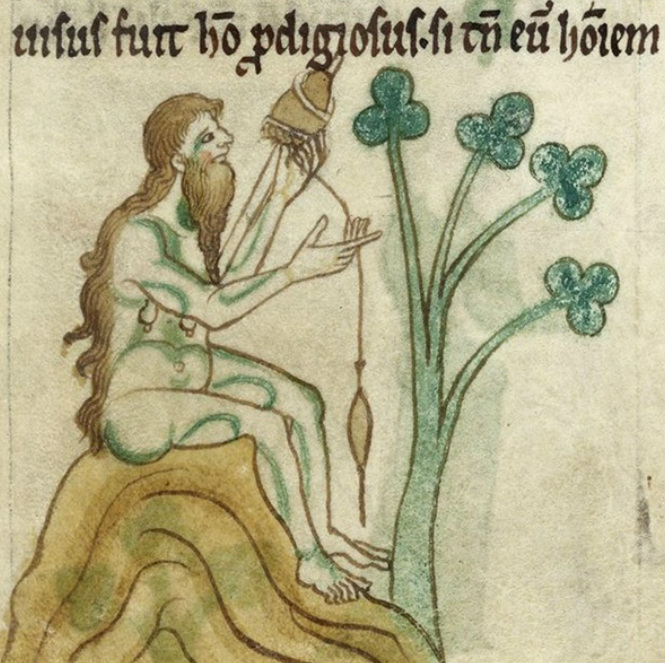 Gerald of Wales (1146-1223), in his portrayal of Ireland, allowed his rather fervid imagination to get the better of him. The bearded woman of Limerick, described in his Topography of Ireland, was his way of using 'abnormal' gender to frame the Irish as wild and unruly. (British Library Royal 13, B. viii, folio 19r: identified as free of known copyright restrictions) Gerald of Wales (1146-1223), in his portrayal of Ireland, allowed his rather fervid imagination to get the better of him. The bearded woman of Limerick, described in his Topography of Ireland, was his way of using 'abnormal' gender to frame the Irish as wild and unruly. (British Library Royal 13, B. viii, folio 19r: identified as free of known copyright restrictions) IF YOU'VE EVER thought that the question of gender identity is a modern phenomena, think again. Back in the tenth century, the Anglo-Saxon Church created what we might call 'gender trouble'. In a sense, the Anglo-Saxons even had a word for it ... To really get into the mindsets of people who lived hundreds of years ago, it's important to understand how people used language. Perhaps only then do we grasp the nuances of their lives and thoughts. Sometimes understanding a single word or an idiomatic term can open up cultural meaning. A case in point is the Old English word bædling, which appears in a penitential text known today as the Old English Canons of Theodore. (Penitentials, by the way, are handbooks that were used by priests to help them decide how much penance should be done for a particular sin – great weekend reading!) This Old English text goes back at least to the end of the tenth century and possibly much earlier. It wasn’t as the title suggests authored by Theodore, who was a seventh-century Archbishop of Canterbury. Rather it was an English version of a compilation of Latin judgments attributed to him, a text now known as the Penitential of Theodore (or, as I like to call it, Theodore's Greatest Hits). I emphasize here version, because though clearly the Old English penitential owes a great deal to the Latin, it would be erroneous to think of it as a translation in the modern sense. The writer of the Old English Canons (we don’t know who that was) reorganized quite a bit of the material, did a little adding and quite a lot of subtracting, tweaking and interpreting. It was like that back then. So where does the word bædling fit into all of this? Get to the point, Anglo-Saxon Monk! Well this extremely rare noun is a really important word for helping us think about the way Anglo-Saxons may have thought about gender and gender identity. A bædling, to try to put it into modern parlance, was someone who had 'gender trouble' – at least from the perspective of others. The bædling is mentioned in a series of pronouncements about 'deviant' sexual practices: one of the canons prescribes the very steep penance of ten years of fasting for a man ‘who has sex with a bædling, or with another male, or with a beast’. We should note that a bædling is not considered here to be ‘another male’: this one doesn’t qualify as a wæpnedman, to use the marvellously euphemistic Old English word from the canon, literally meaning a ‘weaponed man/person’. (I don't think I need to spell out the euphemism.) Then two canons later there is another reference, where ten years of fasting is also handed out to the bædling who has sex with another bædling. A little bit of explication is then offered by the canonist: ‘They [the bædlings] are soft like a harlot’! Umm ... I think it’s pretty obvious that bædling is not a particularly friendly term: it wasn’t chosen by the individuals concerned; it was imposed from on high, so to speak. But it must have been a recognizable term. It's distinctly English, not directly corresponding to any word in the Latin source text. A bædling appears to have been the way this English canonist conceived of someone not fitting into the biblical binary of ‘male and female he created them’. One scholar, R. D. Fulk, has suggested bædling may derive from the word bæddel, corresponding to 'hermaphrodite', which leaves the possibility that the bædling was viewed as some kind of descendent or associate of a mixed-sex (or intersex)person. ('Hermaphrodite', by the way, is not exactly a friendly term either.) Interestingly, the -ing suffix is used in Anglo-Saxon genealogies, and poetry too, to signify 'the son of'. So the bædling may have been used in a similar way, to mean the son of an hermaphrodite. Leaving aside the issue of forbidden sexual intercourse, which is the only reason the bædling gets a mention in the first place in this penitential, I often wonder if all of this was a philosophical or theological problem for the ecclesiasts of the day: what to do with these pesky persons who don’t fit into a nicely and divinely ordered gender system! It’s interesting that another Anglo-Saxon text, Liber monstrorum (book of monsters), written probably around the turn of the eighth century, has as its first monster a person who appeared physically, from his upper body, to be more like a man, but who enjoyed being and living as a woman. So, I guess, one solution for some Anglo-Saxons was to think of atypically gendered persons as monsters! All this very much brings to mind the problem many of us may have today dealing with people who don’t fit neatly into narrow prescriptions of gender, transgender people, for example; or, indeed, the related difficultly we may have of handling sexual orientations that don't fit into the 'norm'. I revised this post today because I was rather moved by a video I saw last week, one that you may have seen too, as it went viral. A young man in the US came out as gay to his family, an act that showed he had tremendous courage, as he met with vile abuse from those who should have loved him. Is it not alarming, then, that in many ways we’ve hardly moved on from monsters and bædlings? Let me know what you think. Leave a comment. Useful sources for more detailed discussion of the bædling: David Clark, Between Medieval Men: Male Friendship and Desire in Early Medieval English Literature (Oxford: Oxford University Press, 2009), pp. 58-67; Allen J. Frantzen, Before the Closet: Same-Sex Love from Beowulf to Angels in America (Chicago: University of Chicago Press, 1998), pp. 163-75, and ‘Between the lines: queer theory, the history of homosexuality, and Anglo-Saxon penitentials’, Journal of Medieval and Early Modern Studies, 26:2 (Spring 1996), 16-29; R. D. Fulk and Stefan Jurasinski (ed.), The Old English Canons of Thedore, EETS ss. 25 (Oxford: Oxford University Press, 2012), pp. 66-7; R. D. Fulk, ‘Male homoeroticism in the Old English Canons of Theodore’, in Sex and Sexuality in Anglo-Saxon England, ed. Carol Braun Pasternack and Lisa M. C. Weston (Tempe, AZ: ACMRS, 2004), pp. 1-34; and Christopher Monk, ‘Framing sex: sexual discourse in text and image in Anglo-Saxon Englans’ (Unpublished PhD thesis, The University of Manchester, 2012), pp. 127-40. For the Liber monstrorum, an edition and translation is provided as an appendix in Andy Orchard’s Pride and Prodigies: Studies in the Monsters of the Beowulf-Manuscript (1995; revised edition, Toronto, Buffalo, NY and London: University of Toronto Press, 2003), pp. 254-317.
8 Comments
Nicola McNeil
8/9/2014 08:40:49 am
This is perhaps a bit unrelated, but I thought it worthwhile mentioning. Explaining the theme of your book, you mention the story of Lot and the men of Sodom and its relevance for Anglo-Saxon readers of the Hexateuch. This got me thinking about the first time I read this story. Prior to reading, I knew the theme of the story and the ‘sin’ being referenced, yet couldn’t seem to derive this from the story as it stood in the bible. I have only just realised why this was. The phrase which implies that the men of Sodom wish to engage in sexual acts with Lot’s visitors is that they wish to ‘know’ them. I’ve since realised that I was reading the verb phrase 'to know' with a heteronormative bias. I was aware of the meaning this verb phrase in biblical context, but only seemed to read it as such in heteronormative contexts, for example ‘Cain knew his wife and she conceived’. I was clearly missing the key point of the story because I presumed that the men were simply demanding to know the identities of the visitors rather than desiring to ‘know’ them sexually. I thought this was interesting and wanted to share this, though it probably just highlights my careless reading if anything!
Reply
Chris (the Anglo-Saxon Monk)
8/9/2014 09:16:11 am
Thank you so much for your comment, Nicola. It's funny how we tend to read things with a gender or orientation bias. It's so easily done.
Reply
Fae
9/2/2022 01:08:02 pm
Quick question, because I can't find this whole text online: in the Old English Canons of Theodore, what 3rd person pronouns were used for the baedling (ie: masculine, neuter, female, or plural)? You're translating it the "they" -- is it only showing up in the plural form?
Reply
Christopher Monk
16/2/2022 09:09:50 am
My apologies for the slow response. For some reason I'm not being notified when I get comments on posts.
Reply
Christopher Monk
16/2/2022 09:22:54 am
Just to add, the verb 'bete' ('atone', subjunctive) doesn't have a subject pronoun, but this is the pattern with 'bete' and 'faste' in Canons of Theodore as a whole, regardless of the gender. So the translator is obliged to provide the pronoun depending on the context, i.e., if it is obvious from the preceding clause that the subject is a man or a woman, 'he' or 'she' can be given. With 'se bædling', however, it is not obvious, so it is better, I think, to translate it as 'that one should atone 10 years'. I hope that makes sense.
Reply
Christopher Monk
16/2/2022 09:39:38 am
One thing more!
Fae
17/2/2022 11:53:39 am
Thank you so much for the translation and the information about glossing this over to Latin. That's helpful in its own sense.
Reply
Christopher Monk
17/2/2022 05:17:24 pm
You're very welcome. Your comment will be posted after it is approved.
Leave a Reply. |
Details
|

